K12 Education Market Insights, 2031
The global K12 education market size and growth was valued at $103.5 billion in 2021, and is projected to reach $525.7 billion by 2031, growing at a CAGR of 17.7% from 2022 to 2031.
Virtual online learning in K 12 schools uses a range of electronic communication techniques to conduct the class, including online chat, video conferencing, synchronous conferencing, and specifically built software, with teachers and students geographically separated.
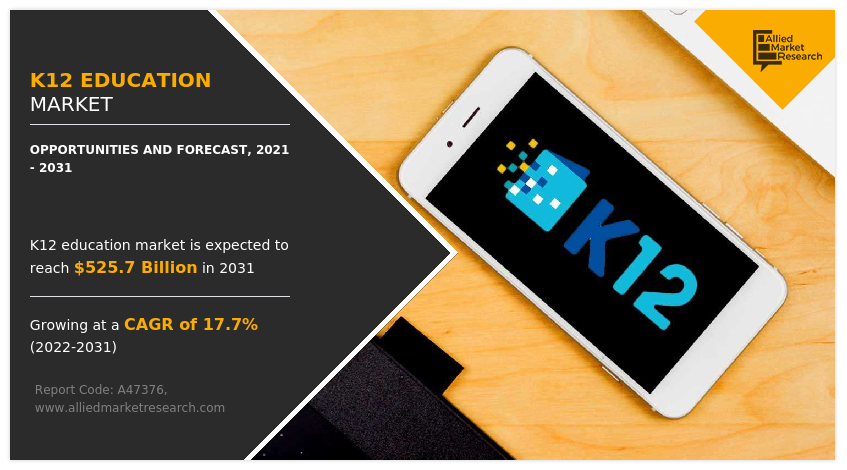
The millennial generation's K–12 kids are digital natives who, generally speaking, are considerably more comfortable with technology than their parents and teachers. Another sector experiencing rapid growth and change is online education for children in grades K–12. K-12 education is integrated to enhance time more effectively to meet the needs of all students.
The use of learning analytics in the educational sector has grown in prominence owing to quick technical advancements. Therefore, educational institutions can provide a customized learning experience with the help of K12 education. K12 is backed by technologies such as artificial intelligence. Based on student profiles, performance, and engaged behavior, it offers tailored content. Therefore, institutions are making significant investments in virtual learning models, which are projected to drive the expansion of the K12 education market forecast.
One of the main disadvantages of e-learning platforms is their inability to generate social interaction with other learners and instructors. Students with higher peer interaction on online learning platforms tend to have a degree higher learning achievement and satisfaction than that of students with no or lesser peer engagement in their learning process. This scenario is estimated to create an imbalance in the penetration rate of e-learning platforms, thereby restraining the K12 education market growth. In addition, limited access to technology poses a major hurdle, particularly in rural and underserved areas. Several students encounter obstacles in obtaining dependable internet, computers, and various digital tools, hindering their capacity to participate in online learning and make effective use of digital educational resources.
E-learning platforms are more time effective and cost-effective for learners. With e-learning platforms, learners possess the convenience of education irrespective of time and location. This factor is anticipated to change the market growth majorly. Moreover, learners can schedule their classes according to their own lifestyles and needs. This factor encourages individuals of various age groups to adapt to e-learning platforms that promise great opportunities for the K12 education market. Many educational institutions save a lot of money by using e-learning platforms to train and educate students with e-learning solutions, as there is no need to employ a physical classroom, resulting in lower monetary expenditure.
Conversely, the K12 online education market is expected to provide several opportunities for new players in the market. Rise in adoption of Learning Management Systems (LMS) like Google Classroom, Canvas, and Blackboard to organize lessons, track progress, and engage students in digital learning environments, streamlining administrative processes and centralizing learning materials. In addition, the increase in the use of smartphones and tablets has encouraged mobile learning, with educational apps and content designed for mobile devices enabling students to learn anywhere and at any time. Furthermore, interactive and gamified learning tools, such as educational games, virtual simulations, and platforms like Kahoot, Quizlet, and Duolingo, are making education more engaging and enjoyable for students, both in-school and at-home. Moreover, personalized learning is gaining traction with adaptive learning solutions that use data to customize learning pathways for individual students based on their strengths, weaknesses, and learning pace, offering more tailored and effective educational experiences. In addition, hybrid and blended learning models, combining in-person and online learning, offer flexibility and personalization, creating opportunities for content providers, LMS developers, and teachers to collaborate on designing effective blended learning environments. These factors are expected to provide remunerative K12 education market opportunities.
For instance, Khan Academy, founded by Sal Khan, is the third app on our list of essential learning apps for the K12 online education market. It offers personalized learning and comprehensive content, benefiting both students and teachers. Accessible via web browsers and mobile devices, Khan Academy boasts approximately 168.7 million registered users.
The surge in focus on mental health and well-being in educational institutions presents numerous opportunities to create high level products and services that foster emotional intelligence, resilience, stress management, and awareness of mental health issues. This encompasses wellness applications, social-emotional learning (SEL) initiatives, and resources aimed at assisting students in stress management and the develop of positive behaviors. Furthermore, there is an opportunity to enhance counseling and mental health services in schools, particularly through telehealth platforms or digital tools offering virtual counseling, therapy, and emotional support for students. This is expected to offer lucrative opportunities for the growth of the market.
For instance, on October 4, 2024, Headstream partnered with The Jed Foundation (JED) and The Meadows Mental Health Policy Institute, launched the K-12 Mental Health Tech Navigator to help U.S. school administrators enhance mental health services. This free web-based tool guides K-12 leaders in choosing digital mental health products, offers case studies, and provides funding advice. It particularly encourages schools with high populations of marginalized students to use the tool.
Market Trends Insights:
The K12 education market is expected to witness several noteworthy edtech trends. One of the prominent trends the market is expected to witness is the integration of advanced technology such as artificial intelligence (AI) into educational products to enhance personalization, with AI-driven learning tools providing tailored experiences, personalized feedback, and customized learning paths suited to each student's learning style. In addition, AI is used to automate administrative tasks such as grading assignments and exams, freeing up teachers' time to focus on direct student engagement and teaching. These systems offers real-time feedback, helping students outside the classroom by identifying knowledge gaps and suggesting resources to improve understanding. As globalization increases, K-12 schools are broadening their international education initiatives through virtual exchange programs, collaborative global tools, and international projects, enabling students to connect with peers around the globe and boost their global awareness. Moreover, there is an increasing focus on teaching multiple languages, with schools utilizing applications, platforms, and immersion techniques to instruct students in languages such as Mandarin, Spanish, and French, equipping them for a global job market.
For instance, on February 11, 2025, Stanford University launched the Generative AI for Education Hub as part of the SCALE initiative to provide research on AI use in K-12 schools. The hub offers a repository of studies to help district leaders make informed decisions about AI tools. Director Chris Agnew emphasized the hub's role in providing evidence, filling research gaps, and offering guidance. The hub aims to identify effective AI tools and simplify the use of ed-tech products in schools. Agnew's team will work with districts and ed-tech innovators to study AI's current and future impact on education.
Another notable K12 education market trend the market is expected to witness is the increase in the integration of inclusive education with assistive technology tools, including speech-to-text programs, screen readers, and tailored learning platforms, to assist students with disabilities and guarantee their complete involvement in the educational experience. In addition, there is shift in preference toward educational institutions, prioritizing the creation of varied learning environments that address the needs of students from different backgrounds, such as ethnic minorities, students with special needs, and English Language Learners (ELL), encouraging diversity in teaching methods, materials, and delivery approaches. Furthermore, there is growing emphasis on sustainability, with schools adopting green technologies, recycling programs, and sustainable building practices to reduce their environmental footprint. Moreover, schools are incorporating environmental sustainability into their curricula to educate students about climate change, renewable energy, and conservation, empowering the next generation to become environmentally conscious citizens.
For instance, on November 17, 2023, Microsoft and Sanoma Learning announced their collaboration to improve educational tools for teachers and students. They integrated Sanoma’s learning materials into Microsoft Teams to simplify administrative tasks and provide seamless access to digital content. The Primary Education solution Bingel, widely used in Belgium, Finland, and Sweden, was the first to be integrated. Microsoft’s Learning Accelerators, starting with the Immersive Reader, were added to Sanoma’s platforms to enhance learning outcomes and support inclusive education. These tools are available in Sweden, Finland, Poland, Italy, Spain, and the Netherlands.
These edtech trends and innovations, including the integration of science technology such as artificial intelligence, are expected to fuel the growth of the K-12 education technology market in the upcoming years. With data-driven approaches, schools are better equipped to create learning environments that are not only more personalized but also more inclusive, global, and sustainable, ensuring a more dynamic and forward-looking education system.
Competitive Analysis
The key players for K-12 education analysis in this report include IBM Corporation, Adobe, Microsoft Corporation, Samsung, D2L Corporation, Oracle Corporation, Pearson Media Company, Knewton, Cengage Group, and Smart Technologies.These key players have adopted various strategies, such as product portfolio expansion, mergers & acquisitions, agreements, geographical expansion, and collaborations, to increase their market penetration and strengthen their foothold in the K12 education market.
Segment Review
The K12 education market size is segmented on the basis of type, deployment mode, application, spend analysis, and region. By type, the market is classified into public and private. By deployment mode, the market is divided into cloud and on-premise By application, the market is classified into high school, middle school, and pre-primary school and primary school. By spend analysis, the market is divided into hardware, software, and others. By region, the K12 education market is analyzed across North America, Europe, Asia-Pacific, and LAMEA.
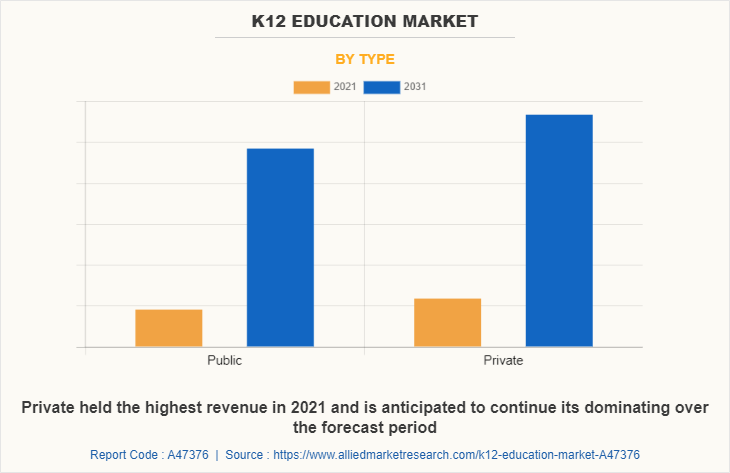
By type, the private sub-segment dominated the K12 education market in 2021. Technology has changed education, such as student information systems (SIS) that simplify attendance tracking and grade books, test prep software, smartboards, and paperless classrooms. These innovations, including AR, VR, machine learning, and digital textbooks, will witness higher growth during the forecast period. Several private educational institutions are focusing on safeguarding confidential data from cybersecurity attacks and how to leverage it to improve student outcomes. All these aforementioned factors are likely to boost the growth of the K12 education market.
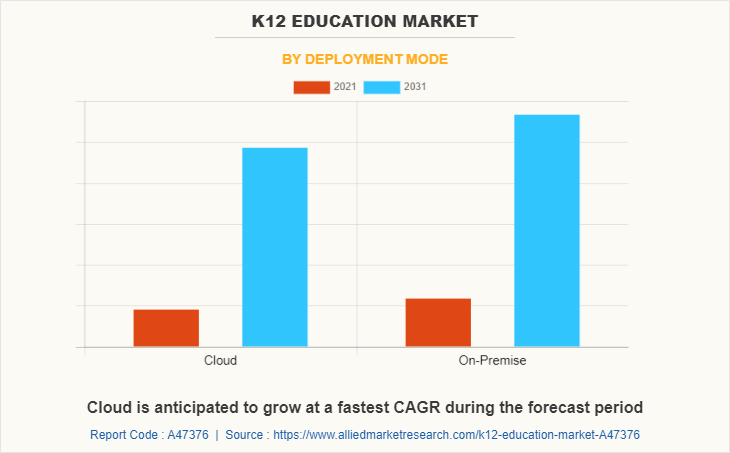
By deployment mode, the on-premise sub-segment dominated the K12 education market in 2021. The adoption of on-premises is expected to grow significantly in the coming years as it runs in a combination of both private and public clouds and provides benefits such as security, cost, control, and speed. Furthermore, on-premises, all generated data is collected and securely stored in the cloud, where it can be accessed from added complexity and can eliminate many securities risks. These factors are propelling the growth of the on-premise sub-segment.
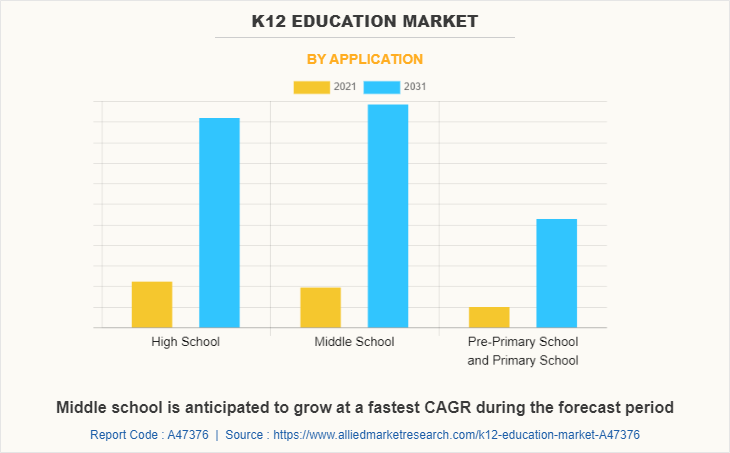
By application, the high school sub-segment dominated the global K12 education market share in 2021. Many educational systems throughout the world has standardized that a child receives at least the primary and secondary levels of education. Within primary and high school education, gamification is one of the most prevalent trends among online education providers to encourage learning through immersive experiences. Simulation of concepts, level advancement badges, and incentive-based learning drive user engagement on online education platforms. Online learning players nowadays are continuously competing to offer differentiated products to the target audiences, mostly by offering value added services with regular courses.
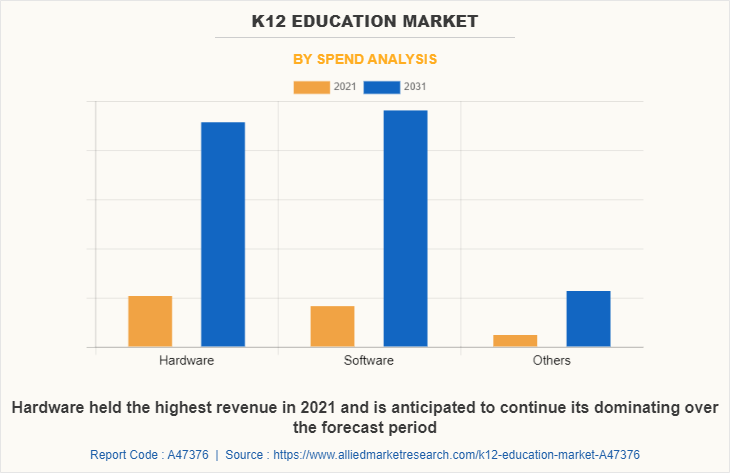
By spend analysis, the hardware sub-segment dominated the global K12 education market share in 2021. E-learning content providers deliver online course libraries and virtual training labs to individuals and enterprises. Course libraries are organized around subjects, commonly leadership and compliance related topics and competencies. Some of the major players in the industry are Udemy, LinkedIn Learning, Coursera, and others.
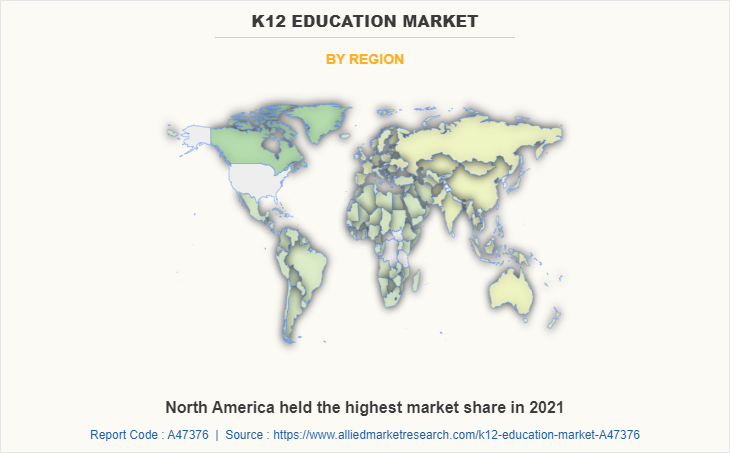
By region, North America dominated the global K12 education market in 2021. North America is dominating region in the K12 education industry owing to the increase in demand for distance learning during the COVID-19 pandemic. In addition, the COVID-19 pandemic has forced various organizations to adopt digital solutions in a bid to train frontline workers, which in turn, fuels the growth of the K12 education market. The U.S. is expected to be a major contributor to the market owing to the availability of high-speed Internet and the advent of the 5G network. In addition, the 5G network enables service provider to improve learning through the incorporation of AR & VR technologies that require a high-speed Internet connection for effective operation. Moreover, technological advancement in digital infrastructure in the U.S. and Canada is likely to boost the North America K12 education market.
Key Benefits for Stakeholders
- This report provides a quantitative analysis of the market segments, current trends, estimations, and dynamics of the K12 education market analysis from 2021 to 2031 to identify the prevailing K12 education market opportunities.
- The K12 education market research is offered along with information related to key drivers, restraints, and opportunities.
- Porter's five forces analysis highlights the potency of buyers and suppliers to enable stakeholders make profit-oriented business decisions and strengthen their supplier-buyer network.
- In-depth analysis of the K12 education market segmentation assists to determine the prevailing K12 education market opportunities.
- Major countries in each region are mapped according to their revenue contribution to the global K12 education market.
- Market player positioning facilitates benchmarking and provides a clear understanding of the present position of the K12 education market players.
- The report includes the analysis of the regional as well as global K-12 education trends, key players, market segments, application areas, and K12 education market growth strategies.
K12 Education Market Report Highlights
| Aspects | Details |
| Market Size By 2031 | USD 525.7 billion |
| Growth Rate | CAGR of 17.7% |
| Forecast period | 2021 - 2031 |
| Report Pages | 300 |
| By Type |
|
| By Deployment Mode |
|
| By Application |
|
| By Spend Analysis |
|
| By Region |
|
| Key Market Players | Adobe Systems Inc., Microsoft Corporation, BLACKBOARD MEDIA PRIVATE LIMITED, smart technologies, Oracle Corporation, Samsung Electronics Co Ltd, D2L corporation, pearson media company, Cengage Group, International Business Machines Corporation |
Analyst Review
The K12 education industry is anticipated to experience considerable growth in the coming years due to the rise in demand for K12 Education in both private and public education systems. The K12 education system is growing majorly due to the rapid growth in the adoption of portable devices that make it easy to gain knowledge and engage in social activities. Moreover, mobile devices are becoming popular for smart learning. However, for students, e-learning systems are more time- and money-efficient. Learners now have the convenience of education regardless of time or place owing to e-learning systems. These factors are expected to significantly drive the K12 education market growth during the forecast period. In addition, students can arrange their class schedules to suit their needs and lifestyle. This factor motivates people of all ages to adopt e-learning systems. This factor offers enormous growth prospects for the key players operating in the K12 education sector.
Asia-Pacific is anticipated to grow at the fastest CAGR during the forecast period frame. The K–12 education sector is expanding quickly in this region as the students are mostly preferring online learning. The education sector in several countries such as China, India, Indonesia, and Malaysia are making their full K–12 curriculum available online.
The global K12 education market size was valued at USD 103.5 billion in 2021, and is projected to reach USD 525.7 billion in 2031
The global K12 education market is projected grow at a compound annual growth rate of 17.7% from 2021-2031
Some key players such as - McGraw-Hill Education, Pearson Education Inc., Cengage Learning India Pvt. Ltd. are the major players in the K12 education market.
Asia-Pacific will provide more business opportunities for the global K12 education market in the future.
Growth in the adoption of smartphones and digital devices in developing countries has been benefitting the K12 education market. Almost 500 million out of 2.8 billion subscribers in Asia-Pacific were enrolled in less than 5 years. This growth rate is expected to continue further and suggests strong growth potential for related services like e-learning platforms across the globe.
Loading Table Of Content...



